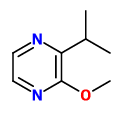Brassica oleracea var. gongylodes L. - Brassicaceae - kohlrabi, German turnip, Kohlrabi
„…biennial vegetable, a low, stout cultivar of wild cabbage. It is another cultivar of the same species as cabbage, broccoli, cauliflower, kale, Brussels sprouts, collard greens, Savoy cabbage, and gai lan. It can be eaten raw or cooked.“ wikipedia
„Volatile compounds of raw and cooked green kohlrabi were investigated using a sensomics approach. A total of 55 odor-active compounds were detected and identified in raw and cooked green kohlrabi using GC-O. Twenty-eight odor-active compounds with high flavor dilution (FD) factors ranging from 64 to 1024 were quantitated, and odor activity values (OAVs) were determined. Eight compounds showed high OAVs in raw and cooked kohlrabi: five sulfur compounds (dimethyl trisulfide, methyl 2-methyl-3-furyl disulfide, and three isothiocyanates (1-isothiocyanato-3-(methylsulfanyl)propane, benzyl isothiocyanate, and 1-isothiocyanato-4-(methylsulfanyl)butane)), two lipid oxidation products (1-octen-3-one and trans-4,5-epoxy-(2E)-dec-2-enal), and 2-isopropyl-3-methoxypyrazine.
Among these, the sulfur compounds contributed most to the overall smell of the raw and cooked vegetables. The quantitation analysis indicates that the eight odorants are the backbone compounds for raw and cooked kohlrabi. The OAVs for the backbone compounds and also for minor odorants are clearly higher in raw kohlrabi than in the cooked one. Differences can be explained by the influence of the cooking process.“
[Marcinkowska, M., Frank, S., Steinhaus, M., & Jelen, H. H. (2021). Key Odorants of Raw and Cooked Green Kohlrabi (Brassica oleracea var. gongylodes L.). Journal of Agricultural and Food Chemistry, 69(41), 12270-12277]

Brassica oleracea var. gongylodes, Hanover County, USA (2023) © freshwaterforager CC BY-SA 4.0 inaturalist.org



